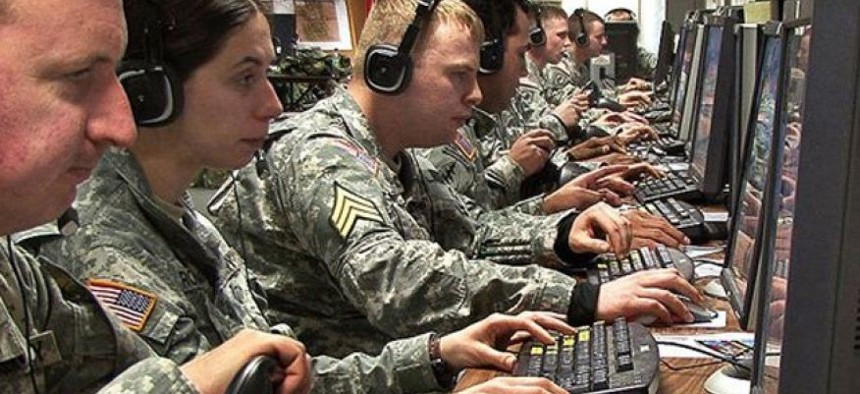Army LOGSA accelerates migration to AI analytics, private cloud computing
The Army’s new LOGSA deal with IBM is designed to leverage advances in AI, cloud computing and analytics.
The U.S. Army is accelerating movement to cloud computing as part of its recent deal with IBM to collect, manage and analyze vast amounts of data across its logistics enterprise, service officials said.
Private cloud computing service comprises the primary element of the Army’s 33-month, $135 million Logistics Support Activity (LOGSA) deal with IBM – a contract extension set up to provide private cloud computing, software development and cognitive computing to the Army’s logistics mission.
“Wherever a solider is in the world, we will give [him or her] more information faster and better analyzed. Newer analysis technologies work faster than what humans have time to look at. This is really going to take us to a greater sense of awareness regarding our equipment,” said Col. John Kuenzli, LOGSA commander
LOGSA’s primary purpose is to function as a logistics brain for the Army and improve readiness by tracking, analyzing and disseminating Army readiness information through the organization of logistical data.
“We have 70,000 users around the world leveraging our software. If we did not have the cloud, all of those users would have to have downloaded our software apps. Without the cloud, we would have to have many more servers at those locations to satisfy demand,” Kuenzli said.
Greater cloud utilization is enabled through increased virtualization, the use of AI and cognitive computing analytics from systems such as IBM’s well-known Watson computer, said Tim Kleppinger, IBM’s vice president and senior client partner for Army and Marine Corps global business.
The effort is designed to organize data more efficiently and to speed up commander’s decision-making ability,
One analyst said emerging advances in AI, cloud computing and analytics such as those offered by Watson and private cloud migration bring previously unprecedented advantages to data management.
“The cloud allows you to bring previously isolated forms and sources of data together, allowing you potentially to draw new insights,” said Peter Singer, strategist and senior fellow at the New America Foundation.
Given rapid advances in private cloud computing, Kuenzli said, the Army is able to create economies of scale in a cost-saving manner. For instance, the use of cloud-enabled common software applications allows the Army to utilize one software license and make it available to everyone at the same time.
Army and IBM developers emphasize that accelerated virtualization, using more AI technologies such as those offered by Watson, permits the service to pay only for services actually used.
“Virtualization allows you to take existing hardware and software and consolidate it into an environment where you can provide only the storage that the Army uses,” Kleppinger said.
IBM says the new deal extension, which builds upon a previous 2012 Army-IBM deal, will expand upon existing Army savings of $15 million per year in operational costs due to data consolidation and storage efficiencies.
“We are leveraging virtual machines and cloud computing in an infrastructure that allows us to pay as we go. We get cutting edge cloud computing capability without having to own all of the infrastructure,” Kuenzli explained.
Overall, the Army system, operated by Army Materiel Command, operates two petabytes worth of data. The system manages large equipment inventories and repairs, such as those needed for combat vehicles, helicopters and trucks along with vast amounts of smaller items spanning from small arms inventories to software and data services.
“We enable users to go in and out of a system within a very small technical footprint. We make all of that available 24-7 to Army users with system access,” Kuenzli said.
Enabling greater interoperability, data-sharing and faster network access can shine a spotlight on security issues in a double-pronged manner. In one sense, streamlining information can make data less dispersed and varied, therefore making it easier to protect. At the same time, some raise the concern that fewer points of access could avail potential intruders an opportunity to launch a more targeted attack and enable them to reach, and potentially cause damage, deeper into networks.
IBM developers emphasize that movement toward private cloud computing, in the case of LOGSA, applies particular risk management framework security controls for the entire IT enterprise. Improvement methods can replace legacy IT security standards, IBM said.
“Cloud computing arguably aids with cybersecurity, as it allows users to see patterns and anomalies that might not be as easy to find otherwise,” New America’s Singer said.
While explaining how algorithms used by Watson quickly allow users to recognize anomalies, Kleppinger identified the effort as Enterprise Resource Planning, a term intended to connote integration of both software and hardware from the Army’s private cloud apparatus at Redstone Arsenal, AL.
The entire effort seeks to actualize the open architecture framework to quickly leverage and integrate new algorithms and analytical techniques. In addition, it parallels sweeping DOD efforts to reduce hardware footprints across the IT enterprise and maximize interoperability.




